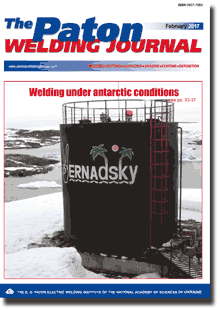| 2017 №02 (02) |
DOI of Article 10.15407/tpwj2017.02.03 |
2017 №02 (04) |

The Paton Welding Journal, 2017, #2, 13-18 pages
Producing dissimilar joints of molybdenum–stainless steel using vacuum brazing
S.V. MaksYmova, V.V. Voronov, P.V. Kovalchuk and A.V. Larionov
E.O. Paton Electric Welding Institute, NASU 11 Kazimir Malevich Str., 03680, Kiev, Ukraine. E-mail: office@paton.kiev.ua
Abstract
In this work the possibility of using brazing alloys with the structure of a solid solution based on Cu–Mn–Ni system for brazing dissimilar joints of molybdenum-stainless steel was shown, the results of micro X-ray spectrum examinations and strength characteristics of brazed joints were presented. The micro X-ray spectrum examinations revealed that in producing dissimilar joints of molybdenum-stainless steel using brazing alloys based on Cu–Mn–Ni system the central zone of a brazed weld is composed of a solid solution on copper base. The diffusion zone of weld (on the side of molybdenum) is formed by the phase based on molybdenum, which is precipitated in the form of a continuous band along the brazed weld. The application of brazing alloy based on Cu–Mn–Ni system with the structure of a solid solution provides formation of dense brazed welds without cracks. The shear strength is at the level of 200–210 MPa during fracture in the brazed weld and at 300 MPa during fracture in the base metal (molybdenum). 9 Ref., 3 Tables, 10 Figures.
Keywords: dissimilar joints, vacuum brazing, brazing alloy, structure, solid solution, weld, mechanical properties
Received: 24.10.16
Published: 16.03.17
References
- http://stroirem.net/board/i-121776/svarka-svarivanie-raznorodnykh-tsvetnykhmetallov
- NEFT-GAZ. http://www.tehn.oglib.ru/bgl/4010/577.html
- http://www.metotech.ru/art_ molibden_1.htm
- TK RZM-Metallurgiya. http://uralferrum.ru/molibden
- Palmer, A.J., Woolstenhulme, C.J. (2009) Brazing refractory metals used in high-temperature nuclear instrumentation. In: of 1st Int. Conf. on Advancements in Nuclear Instrumentation Measurement Methods and their Applications — ANIMMA (7–10 June, 2009, Marseille, France). IEEE, 2009. https://doi.org/10.1109/animma.2009.5503815
- Lebedev, V.K. et al. (2006) Machine building: Encyclopedia. Ed. by B.E. Paton. Moscow: Mashinostroenie.
- Tits, T., Wilson, J. (1968) Refractory metals and alloys. Moscow: Metallurgiya.
- Drits, M.E., Bochvar, N.P., Guzej, L.S. et al. (1979) Double and multicomponent copper-based systems. Moscow: Nauka.
- Chzan-Bao-Chan (1958) Examination of ternary copper alloys Cu–Ni–Mn. Izvestiya Vuzov. Tsvetnaya Metallurgiya, 5, 107–115.
